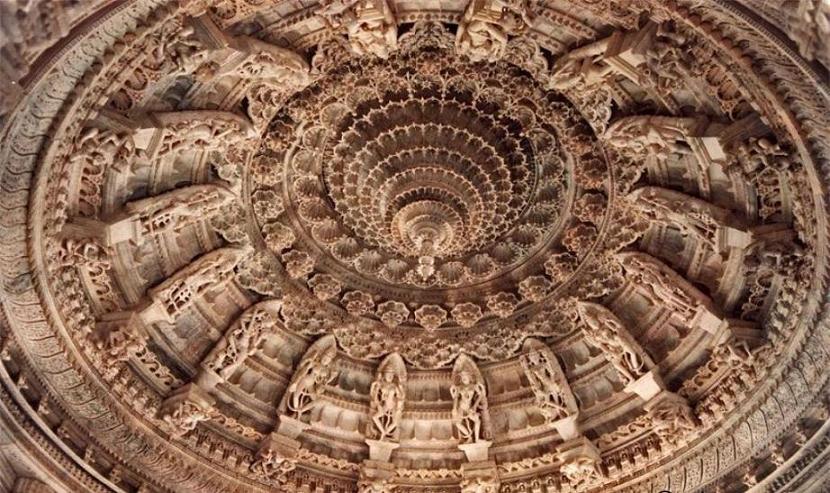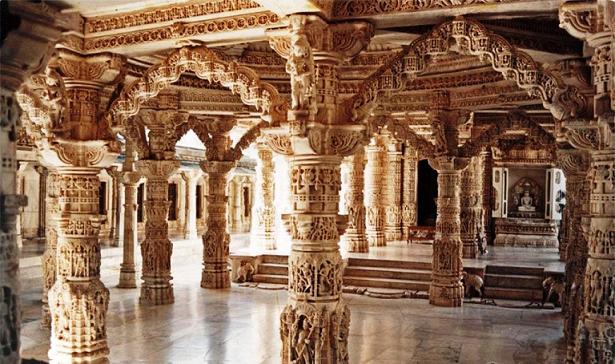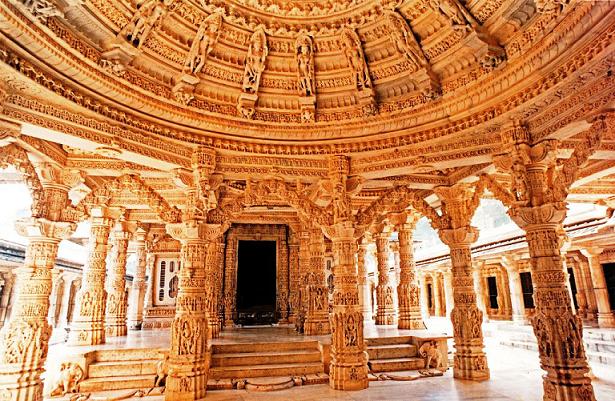Maunt Abu
 |
The Dilwara temple complex at Mount Abu in the south-west of Rajasthan, close to the border of Gujarat, is One of the most important shrines of the Jains. Driving up from Abu Road, along the winding road to the plateau, the visitor finds himself transported from an arid and barren region to an altogether different world. The scenery is characterised by granite rocks, date palms, mango trees, bamboos, orchids and rose creepers. Black-faced langur's frolic alongside the road: even bears and panthers roam free in this habitat.
The Abu plateau, at an altitude of between 1.000-1.700 m, has a climate almost similar to that of the Mediterranean: in winter, the temperature does not exceed 7'C and in summer, it does not rise beyond 32°C. The annual rainfall of approximately 1,600 mm is unusual for Rajasthan and is probably responsible for the abundant vegetation. It is, therefore, not surprising that Mt. Abu is a favourite hill resort for Indians wanting to escape the summer heat. As such, the approximately twenty thousand inhabitants and the inordinately high number of hotels in Mt. Abu are dependent on the tourists for their livelihood. Certain places of interest such as Sunset Point or the Pearl Lake (Nakki Lake) with its Edwardian architecture as well as the summer residences of the various maharajas attract visitors not for the idyll they present but rather for the opportunity they offer to get a closer look at the colourful and exuberant Indian way of life. It is thanks to these hordes of people descending on Mt. Abu that the Dilwara Temples are now open to the public only after noon; the forenoon reserved for the temple service and pilgrims Photography strictly prohibited because in India, as elsewhere, honeymooners love to be photographed in front of historically important monuments. The trust which is responsible for the administration of the temple, believes that this would be-at variance with the religious atmosphere of the shrines.
 |
The name Abu derived from Arbudachala (Arhuda's hill), alludes to the genesis of the mountain. Long ago, the sage Vasishta, Rama's teacher, is supposed to have lived here; even the national epic, the Mahabharata, whose origin dates back to centuries before the birth of Christ, mentions the place as Vasishtashram (home of Vasishta). The saintly hermit possessed a magical cow. Kamadhenu (cow of abundance) which could fulfil any wish an Indian version of Grimm's fairytale, The Table, the Ass and the Stick. One day the cow fell into a big lake and the sage appealed to the gods in the Himalayas for help. The gods sent down the serpent Arbuda who filled up the lake with an enormous rock, namely Mt. Abu, and thus helped the cow reach safety and land again.
According to another legend, this again has Vasishta as its central figure. Abu is one of the original holy places leading to the creation of Rajasthan or at least to the creation of the most important Rajput clans. When Vishnu dwelt on earth in his sixth incarnation as Parashurama, he systematically exterminated the warrior caste, the Kshatriyas, with his Famous axe. The other gods sought the assistance of Vasishta to maintain the necessary balance within society. The sage then performed the ancient magic fire ritual in his hermitage and from the flames; he brought forth the four clans of Rajput, born of fire. These were the Pratihara, Chauhan, Solanki and Parmar, ever since these clans have played a crucial role in shaping the history of Rajasthan. Even the royal families of Jaipur and Udaipur claim descent from them.
The character of Parashurama provides a mythological explanation for the super cession of the warrior class by the Brahmans Following the Aryan invasion. The Kshatriyas had been the dominant class up to that time. At the same time, this story also illustrates how it was possible for the warrior class to retain its privileged position in Rajasthan. Perhaps the story also provides an insight into the conversion of the former Huns from Central Asia to the Rajput clans by initiation through fire; the Rajput clans were regarded as sacrosanct Even today, visitors are taken ten kilometres outside the city to view the hermitage of Vasishta and the place where he performed the fire ritual.
The Parmars, who ruled over Abu from the 10th to the 14th centuries, probably belonged to this area. This fact is supposed to corroborate a variation of the legend narrated above: in this case, a certain Vishwamitra stole Vasishta's cow. Because of this theft, the sage lit the holy fire, made sacrificial offerings and recited sacred texts until a gigantic hero leapt out of the flames, this hero then brought back the cow. Whereupon grateful sage gave him name of Parmar (slayer of the enemy). Since this story has come down to us from Padmagupta Parimala at the end of the 10th century, it is possible it was fabricated to justify the Parmar rule which had just then been established- The clan is known to have existed historically since the beginning of the 9th century. At that time they were still the vassals of the Rashtrakutas in the Deccan.
 |
Since ancient times, therefore the Hindu is as for the Jains has regarded Abu as holy too. The son of Adinatha the first Tirthankara, believed to have built a temple dedicated to his father in a place named the court of the gods. Later Mahavira came to Mt. Abu in search of enlightenment and, in emulating him, followed hundreds of thousands of Jains. Through the years, they came to do penance and to advance on the path of moksha.
Accurate historical information is not available on the early history of Mt. Abu only mythology. We learn of the Bhil's and Nagas who according to legend, lived here in ancient times The latter worshiped the Goddess Durga which points to the existence of a fertility cult, traces of which remain even in historic times. After this, we come across the names of the first kings. The first ruler, Dhumraja, established the Parmar dynasty in 961 AD. A few decades later Mulraja Solanki of Gujarat extended his sway over this region. As a result, the architecture had great influence of Solanki style and the older Dilwara temples are an example of this. The rulers of this period preferred to employ Jain ministers and Obey, with their legendary wealth, functioned as the founders of the temples
The conquest of Mt. Abu in 1311 by Rao Luniba of the Deora-Chauhan dynasty brought to an end the reign of the Parmars and marked the decline of Mount Abu. He shifted the capital city to Chandravati in the plains and, after the destruction of Chandravati in 1405, Rao Sahasmal made Sirohi his headquarters.
Rana Kumbha famous for buildings in Chittaurgarh and magnificent temples at Ranakpur, wished to establish a Rajput empire with Mewar at its heart. In the pursuit of this ambition he immediately set about conquering Mt. Abu; even if he was driven out of this area very soon, to him goes the credit of having erected the Achalgarh fortress which played an important role in the defence of Abu against the Muslim invaders who attempted to storm it. Abu. The rulers of Sirohi were on very good terms with the British who soon discovered the delights of Mt. Abu. They built a sanatorium here and very often, the English Resident spent the summer here in its salubrious climate. In 1917, the hill entirely given over to the British and their imprint is visible on the architecture of the buildings surrounding Nakki Like, splendid examples of colonial British building style. After Independence in 1947, the area restored to the rulers of Sirohi. However, since 1956, Mt. Abu has been a part of the State of Rajasthan.
-----------------------------------------------------
Article Source : "Jainism And The Temples of Mount Abu And Ranakpur"
Publisher : Gyan Gaurav Publishers. C-34, Sir Pratap Colony, Airport Road, Jodhpur
Tele : 91-291-2515861, 9414127863, Editor : Mr. Dilip Surana
Layout & Graphics : Antesh Choudhary
Text : Lothar Clermont, Photos : Thomas Dix,
Printer : First Printed 1998, Reprinted 2006 by Thomson Press, New Delhi
Volume : 96 pages, Size: 242 x 312 mm
-----------------------------------------------------
Mail to : Ahimsa Foundation
www.jainsamaj.org
R240207